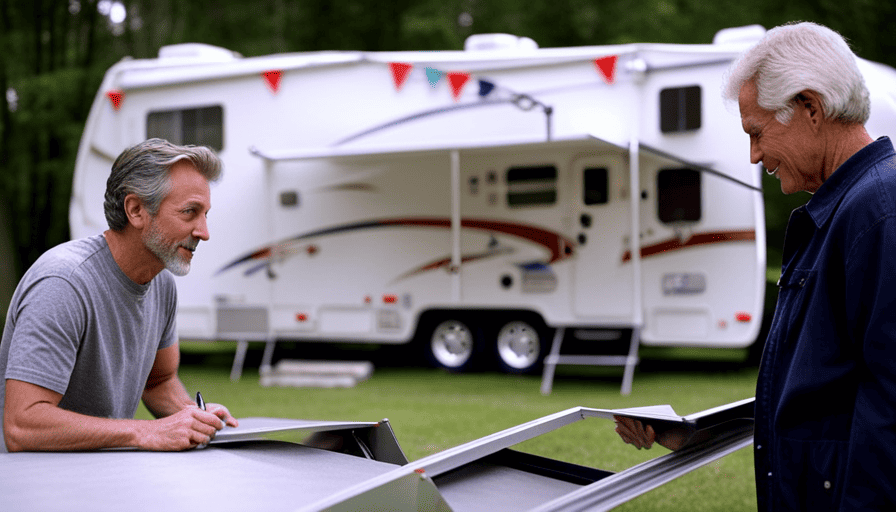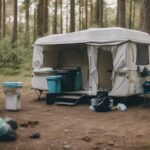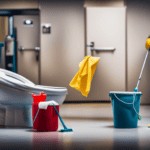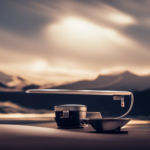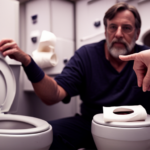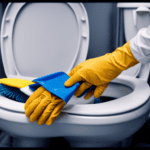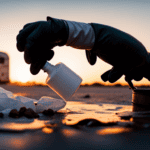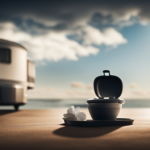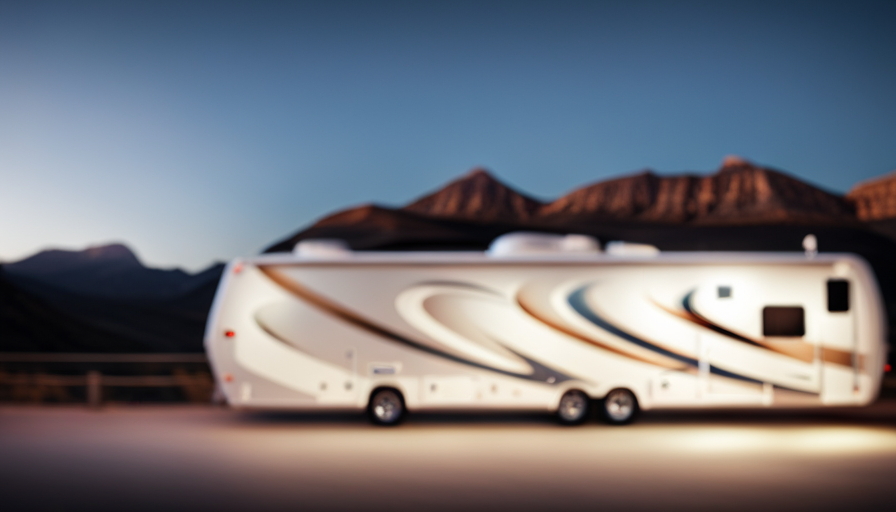Are you aware that more than 40 million Americans go RV camping annually? That’s a significant number of individuals embarking on road trips and reveling in the beauty of nature. If you’re someone who enjoys exploring in a camper, then you understand that emptying the toilet is an essential aspect of the adventure.
It may not be the most glamorous task, but it’s important to know how to properly empty a camper toilet to ensure a clean and odor-free environment. In this article, I will guide you through the step-by-step process of emptying your camper toilet. From gathering the necessary equipment to finding a dump station and properly maintaining your toilet, I will provide you with all the knowledge you need to keep your camper fresh and clean.
So let’s get started on this important aspect of RV camping!
Key Takeaways
- Properly emptying the camper toilet ensures a clean and odor-free environment.
- Dump stations can be found at campgrounds, RV parks, or rest areas.
- Empty the waste tank at the dump station by opening the waste tank valve and closing it tightly after emptying.
- Rinse and clean the tank using a hose or designated rinse hose at the dump station, adding a cleaning solution or tank deodorizer.
Gather the Necessary Equipment
Now, let’s get everything you’ll need to empty that camper toilet. The first thing you’ll need is an emptying technique. There are a few different ways to go about this, but the most common method involves using a hose attached to a dump station. This allows you to safely and cleanly dispose of the waste without any mess.
Next, you’ll need to gather the necessary supplies. This includes a sewer hose, gloves, and a bucket. The sewer hose is essential for connecting your camper’s waste tank to the dump station. Make sure it’s long enough to reach comfortably. Gloves are crucial for protecting your hands from any potential spills or leaks. Lastly, a bucket can be handy for rinsing out the hose or any other cleaning tasks.
Once you have all your equipment ready, it’s time to find a dump station. These can usually be found at campgrounds, RV parks, or rest areas. Look for signs or ask the campground staff for directions. Remember to follow any guidelines or regulations in place at the dump station.
With your equipment gathered and a dump station located, you’re now ready to move on to the next step of emptying your camper toilet.
Find a Dump Station
To locate a dump station, simply search for one nearby. Many campgrounds and RV parks have dump stations available for campers to use. You can also use online resources or mobile apps specifically designed to help you find dump stations in your area.
When searching for a dump station, consider the following options:
-
Public Campgrounds: Many state and national parks offer dump stations for campers. These facilities are usually well-maintained and easily accessible.
-
RV Service Centers: Some RV service centers have dump stations available for public use. These stations are often equipped with additional amenities like water and propane refill stations.
-
Rest Areas and Truck Stops: In some cases, rest areas and truck stops may have dump stations that can be used by campers. However, these options may not always be available or suitable for waste disposal.
Finding alternative waste disposal options is important for maintaining the cleanliness and hygiene of camping areas. Improper waste disposal can lead to environmental contamination and health hazards for both humans and wildlife. With proper waste disposal, we can ensure that camping areas remain enjoyable for everyone.
Now that you know how to find a dump station, let’s move on to the next step: preparing the camper toilet.
Prepare the Camper Toilet
To prepare the camper toilet for emptying, the first step is to turn off the water supply. This will prevent any additional water from entering the toilet bowl.
Next, it’s important to empty any remaining water in the toilet bowl by flushing it multiple times.
Finally, secure the toilet lid and make sure it’s tightly sealed to prevent any spills during transportation.
Turn off the water supply
First, you’ll want to shut off the water supply to effectively empty the camper toilet. To do this, locate the water shut-off valve, which is typically located behind or near the toilet. Turn the valve clockwise to shut off the water flow. This step is crucial to prevent any water from flowing into the toilet while you’re trying to empty it.
If you’re unable to find the water shut-off valve or if it’s not working properly, you may need to find alternative methods to stop the water flow. This could include turning off the main water supply to the camper or using a temporary plug to block the water from entering the toilet.
Once the water supply is shut off, you can proceed to empty any remaining water in the toilet bowl. This can be done by using a small cup or a sponge to scoop out the water and dispose of it properly.
Empty any remaining water in the toilet bowl
Once the water supply has been shut off, you can begin removing any remaining water in the toilet bowl to ensure a thorough and efficient emptying process. To do this, first, put on a pair of gloves to protect your hands from any potential bacteria.
Next, use a small plastic cup or a sponge to scoop out the water from the bowl and pour it into a designated waste container. Make sure to remove as much water as possible to prevent any leakage during transportation.
Once the bowl is empty, take the time to clean it using appropriate cleaning techniques to ensure a hygienic environment. This will also help in preventing odors.
Finally, once the bowl is clean, securely seal the toilet lid to prevent any further contamination or odors from escaping. This will be discussed further in the subsequent section about securing the toilet lid and seal.
Secure the toilet lid and seal
After emptying any remaining water in the toilet bowl, the next step is to secure the toilet lid and seal it properly. This is an essential part of camper toilet maintenance to prevent any odors or leaks. Here are three techniques to ensure a tight seal:
-
Check the gasket: Inspect the rubber gasket around the toilet lid for any signs of wear or damage. If needed, replace it to ensure a proper seal.
-
Tighten the lid screws: Make sure the screws that hold the lid in place are securely tightened. Loose screws can cause the lid to shift and break the seal.
-
Apply lubricant: To enhance the seal, apply a small amount of silicone lubricant or petroleum jelly to the gasket. This will help create a tight and reliable seal.
By properly maintaining the toilet lid and sealing it tightly, you can prevent any unpleasant odors or leaks.
Now, let’s move on to the next step of emptying the waste tank.
Empty the Waste Tank
Simply slide the spout and swiftly spew out the solid and liquid sludge from the waste tank of your camper toilet. Before you start this process, it’s essential to locate the nearest dump station. Dump station locations can be found at RV parks, campgrounds, or rest areas. Proper waste disposal techniques are crucial to ensure environmental safety and hygiene.
Once you have arrived at the dump station, position your camper toilet close to the designated area and secure it in place. Open the waste tank valve and let the contents flow out smoothly through the spout. Be careful not to spill or splash any waste. Once the tank is empty, close the valve tightly to prevent any leaks. Remember to follow any specific guidelines provided by the dump station for waste disposal.
With the waste tank now empty, it’s time to move on to the next step: rinse and clean the tank.
Rinse and Clean the Tank
To rinse and clean the camper toilet tank, I use a hose or the designated rinse hose at the dump station. I make sure to add a cleaning solution or tank deodorizer and rinse the tank thoroughly to eliminate any odors or residue.
After that, I close the valves and secure the waste tank to ensure everything’s properly sealed.
Use a hose or designated rinse hose at the dump station
Grab the designated rinse hose at the dump station and use it to empty your camper toilet. First, gather all the equipment you need, including gloves and a bucket.
Then, locate a nearby dump station with a designated area for emptying your camper toilet. Once you’re at the dump station, follow these steps to effectively rinse and clean the tank:
- Connect the rinse hose securely to the dump station’s water source.nn2. Insert the other end of the hose into the camper toilet’s waste valve.nn3. Turn on the water and let it flow into the tank, flushing out any waste and debris.
Make sure to add a cleaning solution or tank deodorizer to the tank and rinse thoroughly before moving on to the next step.
Add cleaning solution or tank deodorizer and rinse thoroughly
After securely connecting the rinse hose, I infuse the tank with a refreshing cleaning solution or tank deodorizer. I ensure every nook and cranny is thoroughly cleansed to leave my camper smelling as fresh as a spring morning.
When it comes to cleaning solution options, there are several to choose from. Some campers prefer using natural solutions like vinegar and baking soda, while others opt for commercial products specifically designed for RV toilets.
The benefits of using tank deodorizer are twofold. It not only eliminates odors but also helps break down waste and prevent clogs.
Once I’ve added the cleaning solution or tank deodorizer, I make sure to rinse the tank thoroughly to remove any residue. This step ensures optimal cleanliness and prevents any lingering smells.
Now, it’s time to close the valves and secure the waste tank, ensuring a hassle-free and efficient emptying process.
Close the valves and secure the waste tank
Once the valves are securely closed and the waste tank is properly secured, you can rest easy knowing that your camper maintenance is complete.
It is important to ensure that the valves are tightly closed to prevent any leaks or odors from escaping. Additionally, make sure that the waste tank is securely fastened to avoid any accidents while on the road.
When it comes time to empty the tank, it is crucial to know the dump station locations in your area. These stations are specifically designed for proper waste disposal and will have the necessary facilities to safely dispose of your camper’s waste. Remember to always follow the proper waste disposal methods to protect the environment and maintain cleanliness.
With these precautions in mind, you can now move on to the next step of cleaning the camper toilet.
Clean the Camper Toilet
To effectively clean the camper toilet, it’s essential to thoroughly empty it. Here are four key steps to follow:
-
Gather the necessary cleaning supplies: Before starting, make sure you have all the proper cleaning supplies on hand. This includes rubber gloves, a toilet brush, disinfectant cleaner, and toilet paper.
-
Empty the waste tank: Locate the waste tank valve and open it to release the contents into a designated dumping station or sewer connection. Be sure to follow any campground or local regulations for proper disposal.
-
Clean the toilet bowl: Use a disinfectant cleaner and a toilet brush to thoroughly clean the inside of the toilet bowl. Pay special attention to the rim, seat, and under the seat where bacteria can accumulate.
-
Sanitize the toilet seat: Wipe down the toilet seat with a disinfectant wipe or spray to ensure it’s clean and germ-free.
Remember, after completing these steps, it’s important to wash your hands thoroughly with soap and water. Proper hygiene is crucial in maintaining a clean and healthy camper toilet.
Wash Your Hands
When it comes to washing your hands, it’s important to remember a few key points. First, make sure to use soap and water for at least 20 seconds, thoroughly cleaning all areas of your hands.
After washing, dry your hands with a clean towel or use hand sanitizer if a towel isn’t available.
Lastly, don’t forget to properly dispose of any waste or cleaning materials to maintain cleanliness and hygiene.
Use soap and water for at least 20 seconds
Lather your hands with soap and water for at least 20 seconds, picturing the grime and bacteria being washed away as you scrub vigorously. This may seem like a simple task, but it’s crucial for maintaining proper hygiene. Here are three reasons why using soap and water for 20 seconds is highly beneficial:
-
Effective removal of germs: Soap creates a chemical reaction that breaks down the outer coating of viruses and bacteria, making them easier to rinse off.
-
Reduction of infection risk: Proper handwashing can significantly decrease the likelihood of spreading infectious diseases, such as colds, flu, and gastrointestinal infections.
-
Protection against harmful substances: Soap also helps to remove dirt, oils, and other contaminants that can accumulate on your hands throughout the day.
After thoroughly washing your hands, you can move on to the next step of ensuring cleanliness by drying your hands with a clean towel or using hand sanitizer.
Dry your hands with a clean towel or hand sanitizer
Once your hands are clean, you can either dry them with a clean towel or use hand sanitizer for added protection against germs. When it comes to drying your hands, using a clean towel is a simple and effective option. It helps remove any remaining moisture, leaving your hands dry and ready for the next task. Alternatively, using hand sanitizer can provide an extra layer of germ protection. Simply apply a small amount to your hands and rub them together until the sanitizer is completely absorbed. This helps kill any remaining germs on your hands, ensuring they are clean and sanitized.
To help you understand the benefits of both options, here is a comparison table:
| Clean Towel | Hand Sanitizer |
|---|---|
| Removes moisture | Provides germ protection |
| Reusable | Convenient for on-the-go |
| Requires washing | No need for water |
Now that your hands are clean and dry, it’s important to dispose of any waste or cleaning materials properly. This ensures a clean and hygienic environment for yourself and others.
Dispose of any waste or cleaning materials properly
After drying my hands, it’s important to properly dispose of any waste or cleaning materials to maintain cleanliness and minimize the environmental impact. To ensure proper disposal, here are four important steps to follow:
-
Separate recyclable materials: Sort out any recyclable items such as plastic bottles or cardboard packaging.
-
Dispose of non-recyclable waste: Place any non-recyclable waste, such as used tissues or paper towels, in a designated trash bag.
-
Use designated waste disposal areas: Many campsites or RV parks provide specific waste disposal areas for campers. Utilize these facilities to dispose of your waste properly.
-
Avoid dumping waste in nature: Never dispose of waste directly in natural environments, as this can harm the ecosystem.
By following these proper disposal methods, we can ensure a clean and safe environment for everyone.
Now, let’s discuss how to maintain regular cleaning and maintenance of the camper toilet.
Maintain Regular Cleaning and Maintenance
To keep your camper toilet in good working condition, it’s important to regularly clean and maintain it. This includes emptying the waste tank and sanitizing the bowl. For example, John, a seasoned camper, ensures he cleans his camper toilet every week to prevent any unpleasant odors or clogs. Regular cleaning and maintenance are crucial to ensure the longevity and proper functioning of your camper toilet.
To begin, emptying the waste tank is an essential step in maintaining your camper toilet. This should be done when the tank is about three-quarters full or as needed. To do this, locate the waste tank valve and open it, allowing the waste to flow into an appropriate waste disposal area. Be sure to wear gloves and follow any local regulations when disposing of the waste.
In addition to emptying the waste tank, sanitizing the bowl is equally important. Use a specialized toilet cleaner or a mixture of bleach and water to thoroughly clean the bowl. Scrub the surfaces with a toilet brush, paying extra attention to any stains or residue. Rinse the bowl thoroughly with clean water afterwards.
By regularly cleaning and maintaining your camper toilet, you can ensure its optimal performance and prevent any potential issues.
Next, we will discuss odor-control measures to further enhance your camping experience.
Consider Odor-Control Measures
Maintain Regular Cleaning and Maintenance is crucial to keep your camper toilet in good condition. Now, let’s move on to the next step – Consider Odor-Control Measures, which are essential for a pleasant camping experience. Nobody wants to deal with unpleasant smells while enjoying the great outdoors.
To ensure a fresh and odor-free environment, there are a few measures you can take. Firstly, using deodorizing tablets or chemicals specifically designed for camper toilets can help neutralize odors. These products often come in handy, pre-measured packets that are easy to use.
Additionally, proper waste disposal options are crucial. Emptying your camper toilet at designated dumping stations is not only hygienic but also helps in controlling odors. These stations provide a convenient and sanitary way to dispose of waste.
To help you understand the importance of odor-control measures and waste disposal options, take a look at the following table:
| Odor-Control Measures | Waste Disposal Options |
|---|---|
| Using deodorizer tablets | Emptying at designated dumping stations |
| Proper ventilation | Utilizing portable waste holding tanks |
| Regular cleaning and sanitizing | Utilizing composting toilets |
Remember, maintaining a clean and odor-free camper toilet is essential for a pleasant camping experience. Now, let’s move on to the next section, where we will discuss seeking professional help if needed, ensuring you have all the necessary information to keep your camper toilet in top shape.
Seek Professional Help if Needed
If you encounter any issues or difficulties with your camper toilet, it’s important to consult a professional for assistance. They have the expertise and knowledge to diagnose and fix any problems that may arise.
Contacting camper or RV service centers is also a good option as they specialize in camper maintenance and can provide the necessary assistance.
Finally, it’s crucial to follow the manufacturer’s guidelines or seek expert advice in case of emergencies to ensure the safety and proper functioning of your camper toilet.
Remember, seek professional help if needed.
If you encounter any issues or difficulties, consult a professional
When you face any problems or challenges, it’s best to seek the assistance of a professional for emptying a camper toilet. While emptying a camper toilet may seem straightforward, there are common mistakes to avoid and tips for preventing clogs and blockages in camper toilets. Here are a few things to keep in mind:
-
Common mistakes to avoid when emptying a camper toilet:
- Using excessive toilet paper or disposing of non-biodegradable items in the toilet can lead to clogs and blockages.
- Emptying the tank too frequently or not using enough water when flushing can cause odors and buildup.
-
Tips for preventing clogs and blockages in camper toilets:
- Only use RV-friendly toilet paper that dissolves easily.
- Regularly add a waste digester or treatment product to break down waste and reduce odors.
Remember, if you encounter any issues or difficulties, consulting a professional is always a wise decision. Contact camper or RV service centers for assistance in resolving any problems that may arise.
Contact camper or RV service centers for assistance
Seeking assistance from camper or RV service centers can provide valuable support and guidance for any issues or difficulties related to your recreational vehicle. These professionals have the expertise and experience to help you out when it comes to troubleshooting common toilet issues. Whether it’s a clogged toilet, a leak, or a malfunctioning flush mechanism, they can diagnose the problem and offer suitable solutions. They can also provide advice on proper maintenance and preventive measures to avoid future problems.
However, in case of emergencies or if you’re unsure about how to proceed, it’s always important to follow the manufacturer’s guidelines or seek expert advice. This will ensure your safety and the proper functioning of your camper toilet.
Follow manufacturer’s guidelines or seek expert advice in case of emergencies
To ensure your safety and the proper functioning of your recreational vehicle toilet, it’s crucial to follow the manufacturer’s guidelines or consult an expert in case of emergencies.
When it comes to emptying a camper toilet, it’s important to seek professional advice to avoid any potential mishaps. Different camper toilets have different protocols for emptying, and it’s essential to familiarize yourself with these guidelines.
If you encounter an emergency situation, such as a clog or a leak, it’s best to contact a camper or RV service center immediately. They have the expertise and experience to handle such situations and can provide you with the necessary assistance.
Remember, following the proper emergency protocols and seeking expert advice will help ensure a smooth and trouble-free experience with your camper toilet.
Frequently Asked Questions
How often should I empty the camper toilet?
To properly clean and sanitize a camper toilet, it’s important to empty it regularly. The frequency of emptying will depend on the usage and capacity of the toilet. However, it’s generally recommended to empty the camper toilet at least once a week or when it reaches around 3/4 full.
When disposing of the waste, it’s crucial to follow responsible guidelines and regulations, such as using designated dump stations or waste treatment facilities.
Can I use regular household cleaning products to clean the waste tank?
For proper disposal of camper toilet waste, it’s important to follow the correct methods. Using regular household cleaning products to clean the waste tank isn’t recommended as they may not effectively break down the waste and can harm the environment. Instead, opt for eco-friendly alternatives such as enzyme-based cleaners or biodegradable cleaning solutions specifically designed for camper toilets.
These alternatives are effective in breaking down waste and are safer for the environment.
Are there any specific measures I can take to prevent odors from developing in the camper toilet?
To prevent odors from developing in the camper toilet, there are a few specific measures I recommend. Firstly, regularly clean the toilet with appropriate cleaning techniques, using RV-specific products that are designed to break down waste and eliminate odors.
Additionally, ensure proper ventilation in the camper by opening windows or using fans to circulate air.
Lastly, consider using odor control products, such as deodorizing tablets or sprays, to further combat any unpleasant smells.
Is it necessary to wear gloves when emptying the waste tank?
Wearing gloves is necessary when emptying the waste tank of a camper toilet due to health concerns. This precaution helps protect against potential contact with harmful bacteria and pathogens present in the waste.
It’s important to prioritize personal safety and hygiene during this process. By wearing gloves, you can minimize the risk of contamination and maintain good health while performing the task.
Are there any additional steps I should take to maintain the camper toilet’s functionality?
To maintain the functionality of your camper toilet, there are several steps you can take. Firstly, regularly clean the toilet bowl and tank with appropriate cleaning products to prevent clogs and unpleasant odors.
Secondly, check the seals and connections for any leaks or damage, as these can cause issues with flushing or waste disposal.
Lastly, familiarize yourself with common troubleshooting techniques, such as adjusting water levels or unclogging the toilet with a plunger.
What Steps Should I Take to Winterize My Camper’s Toilet?
When it comes to preparing your camper’s toilet for the winter season, following these essential winterize camper tips is crucial. First, empty the black and gray water tanks and ensure they are thoroughly cleaned. Then, add a non-toxic antifreeze to the system to prevent any remaining water from freezing. Lastly, protect the toilet’s seals and valves by applying lubricant. By taking these steps, you can safeguard your camper’s toilet during the winter months.
Conclusion
In conclusion, emptying a camper toilet may not be the most pleasant task, but it’s necessary to maintain a clean and functional camping experience. By following the proper steps, such as gathering the necessary equipment, finding a dump station, and properly emptying and cleaning the waste tank, you can ensure a more enjoyable trip.
Remember to wash your hands thoroughly and maintain regular cleaning and maintenance to keep your camper toilet in top shape. And if you ever need assistance, don’t hesitate to seek professional help.
Happy camping!


